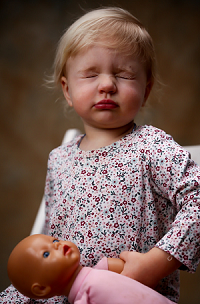Is your toddler biting, hitting, or showing aggressive behaviors? If your child acts out on a regular basis, you may wonder why, and what you can do to prevent it.
A toddler biting, hitting, or otherwise displaying aggression is common. In many cases, these actions stem from strong emotions or an effort to express a child’s feelings. However, most parents agree that a toddler’s aggressive behavior is unacceptable and must be stopped.
If you’ve tried putting your child in time-out for acting out and you still haven’t seen results, this article might help you understand the root of your child’s behavior and how to stop toddler biting, hitting, and other aggression.
Understanding Toddler Aggression: Why Do They Act Out?
Aggressive behavior in toddlers emerges in an attempt to manage strong emotions, though some will show it to greater degrees than others. If your child has autism or special needs, they may be using aggression as a method of communicating or self-soothing.
Sometimes, kids are motivated by experimentation. A toddler acting out during this period is often a way to test boundaries and learn what is and is not an appropriate response during social interactions. If this is the case for your child, it’s a phase that will pass quickly.
If your toddler has just started experimenting with hitting or biting (both of my boys did this around age two), gently catch their little fists or divert those tiny teeth. It’s important to address a toddler biting early because biting hurts! Not just physically but emotionally, toddlers need to understand how their actions affect others. Use clear, simple language, such as, “That hurts! I can’t let you hit me. Ouch!” Whether it’s persistent hitting or biting behavior, it’s crucial to stay calm and consistent with how you respond to a toddler biting and provide healthier ways to express their emotions.
Why Early Intervention is Key: Addressing Toddler Biting & Hitting Behavior
Sometimes, a toddler’s aggressive behavior can become a habit. Despite attempts to nip it in the bud, toddlers may keep acting out. That’s what happened with my four-year-old.
Then, we enrolled him in a new daycare. Suddenly, he was more aggressive than we’d ever seen him. The teachers reported that he was hitting other kids, screaming in people’s faces, pushing other kids, and stealing toys. (Fortunately, no biting).
We didn’t know what to do at first. Sure, these behaviors came up now and again at home, but we hadn’t seen our toddler hitting this frequently before.

I started to question the daycare teachers: How were they handling the situation? What was my son getting the right support? Clearly, he was pushing boundaries.
Since he was four, we were able to talk to him about hitting, and his behavior improved. But as soon as he stopped hitting at daycare, he started acting out more at home. He would throw tantrum after tantrum after coming home, screaming at his brother, and showing more aggressive behavior.
I knew something had to give.
Emotional Triggers: Fear, Frustration, and Beyond
Obviously, we started putting much more attention on preventative measures and the way we reacted to our toddler hitting.
It quickly became apparent that he’d internalized a lot of frustration for such a little guy. But it wasn’t until he started coming home and asking me if he was “a bad kid” that I realized many of the problems were coming from the daycare itself.
I did some reading on the psychology of toddler aggression, and I found that it’s usually motivated by fear or frustration.
If fear is the motivation, it becomes the parent’s job to provide reassurance and show the child they are safe. Most toddlers express frustration through tantrums. I soon learned that my son wasn’t being allowed to throw tantrums at daycare, so he had turned to hitting as an alternative.
Soon, that alternative became his immediate go-to reaction.
Once you understand what causes toddler biting and hitting, you can try these steps to prevent the behavior.
Aggression is almost always motivated by emotion. Aside from fear and frustration, it can also be an expression of anger, jealousy, or sadness. Tantrums give toddlers a way to express emotion that has been internalized and maybe even suppressed.
Adults often convey an unwillingness to experience a child’s big emotions without meaning to. If we see our toddler biting, we look for a quick fix to mitigate the situation without seeing it from the child’s perspective. We tell little ones to stop crying, stop screaming, and quit throwing a fit.
I taught my eldest child to “take a deep breath” whenever he was having a meltdown. At the time, I thought I was giving him a healthy way to cope with his feelings. After all, there are plenty of articles about teaching children to suppress their emotions and “control themselves.”
(Yet, plenty of psychologists will tell you the truth: toddlers aren’t developmentally ready to control their emotions).
So, without meaning to, I taught my son to suppress his emotions and keep himself from crying when he was upset.
I realized he didn’t know how to process his emotions, so he kept hitting. He might have even thought it was bad to have an emotional meltdown, especially because his daycare teachers kept punishing him for these outbursts.
He was also getting time-outs at home for hitting and other aggressive behaviors. I have since learned that time-outs can be counter-productive when it comes to preventing your toddler from hitting.
So, we began a process of recognizing what he was feeling and learning how to fully experience those emotions in a healthy way.
How We Stopped Aggressive Behavior: 6 Steps to Handle Tantrums
Understanding how to stop a toddler from biting or hitting begins with recognizing their emotional triggers and providing them with the right response to express their frustrations and cultivate positive behavior.
First and foremost, for us, was helping our child identify the emotion(s) he was feeling. Then, we would talk to him about it and allow him to fully experience the emotion in a safe environment.
This meant that every time he hit, pushed, or kicked another kid, we would:
Step 1: Stop Aggressive Behavior Immediately, but Gently
Aggressive behavior must be stopped immediately. But because our son was showing aggression, we knew it was important to stop the behavior as gently as possible. We needed to model calm behavior if we wanted our son to learn to stop being so aggressive.
Step 2: Prioritize the Victim’s Feelings
As soon as the behavior had been stopped, and assuming it was safe to do so, we made sure to check that the other child was okay.
We then took time to comfort the child who’d been the target of aggression. This was our way of modeling compassion and reassuring the non-aggressive child that they’re safe.
Step 3: Remove Your Child from the Situation Calmly
Next, we would gently remove our aggressive toddler from the situation. I tried not to berate or scold my child at this point. Especially if he was having a fit, he could not think logically at this stage. Instead, I reminded myself that it was my job as his parent to be the calm in the midst of his storm.
In my case, my son was not processing emotions and was not throwing tantrums. I actually had to “give him permission” to throw a tantrum at first. This meant I had to give him an ultimatum, such as, “You can choose to give the toy back or you can hand it to me and I’ll do it for you.”
A statement like that will cause most kids to burst into tears. But at first, my son still didn’t express emotion at this point. So, I would say, “How do you feel about that?” Only once he knew I was ready for him to express himself would he begin having his meltdown.
Step 4: Let the Tantrum Run Its Course Safely
After removing our child from the situation, we would take him to a safe place where he could have his tantrum without hurting himself or anyone else. Here, it’s the parent’s job to show understanding, compassion, and patience. When throwing a fit, the child has moved beyond the ability to reason. Once the tantrum is over (usually 5-15 minutes), they will regain the ability to think clearly.
Toddlers sometimes try to hurt themselves or others during a tantrum. Simply give them an alternative without stopping the tantrum. If they hit you, just gently redirect their hitting or kicking away from you (I notice my kids are usually too overwhelmed to be effective in hurting me during a tantrum). If a child is banging her head on the floor, placing a pillow under her head keeps her from hurting herself until the tantrum has run its course.
Toddlers often end a tantrum with a hug, or even laughter. You’ll know their fit is over because they’ll be much calmer. Because they were allowed to fully process their emotions, they may even show more patience and kindness after a tantrum is over.
Step 5: Discuss the Situation with Our Toddler
We knew it was important to reinforce the processing of emotion with our son. Because he hadn’t been fully processing things before, we wanted him to consciously acknowledge what had happened.
Often, he had been experiencing a whole array of emotions — sadness at losing a toy, anger and indignation that someone had messed up his game, frustration at being unable to resolve the situation on his own. And all of these emotions again if an adult showed anger at his reactions.
Step 6: Provide Alternatives to Aggressive Behavior
Once a tantrum was over, our son was able to calmly talk about what he’d been feeling without crying again. We would also discuss alternatives to aggressive behavior.
For example, if he gets frustrated, he can say so out loud, or come find a grown-up to help him. (We strongly encouraged the latter since he could not control his outbursts at first. However, he can now do the former because he’s been practicing ways to express himself other than aggression. He has also learned to verbally express his needs and desires to other kids, which is more appropriate for older toddlers).
This experience showed us that our son has a huge heart and a great capacity for compassion.
Often, his outbursts were because he had a strong sense of right and wrong. If he feels he or other kids are the brunt of unfair treatment, he doesn’t hesitate to try to make things right.
My eldest son is also a big softie, like me. He takes things personally, and his feelings get hurt pretty easily. This knowledge helped us empower him to work through those moments when his feelings were hurt.
We were able to teach him to use his conversational skills (boy, does he have a vocabulary!) to tell other kids how their actions made him feel.
He’s since learned that when he tells people how he feels, they’re much more likely to be understanding toward him.
When Daycare Isn’t the Right Fit: The Importance of Supportive Environments for Emotional Growth
We saw results at home almost immediately. Since throwing a tantrum is a natural way for toddlers to express emotion, our son exhibited worlds of patience and calm after fully completing a tantrum. He was like a whole new kid.
However, his aggressive behavior persisted at daycare. He wasn’t hitting anymore, but he was still rough with the other kids, and would frequently steal toys and scream at others.
I introduced this method to the daycare teacher, hoping it would nip this problem in the bud immediately.
However, it quickly became apparent that the teacher wasn’t willing to help our son process his emotions. She didn’t want him throwing tantrums during playtime, and she didn’t want to physically remove him from a situation if he became aggressive. Turns out, the teachers were also telling the kids to sit still for hours at a time.
No wonder my four-year-old son was so frustrated all the time. And no wonder he threw fits when he came home! He wasn’t allowed to wiggle or be loud or have tantrums during daycare hours. So of course, he expressed all this pent-up frustration the moment he got home.
Needless to say, we don’t attend this daycare anymore. After three weeks, they told us they didn’t want my eldest son to come back anymore (though they had the nerve to tell me my younger son could stay). But it didn’t matter, because I was already searching for alternative childcare. It was clear to me the environment wasn’t good for either of my children.
The Role of Support Systems: How an Au Pair Can Help
Adriana joined our family in November 2018. To call her a lifesaver would be a vast understatement. Her focus has been instrumental in helping us reduce our toddler’s hitting.
See Also: Is Living with an Au Pair Right for You?
Adriana is loving and firm when it comes to helping our kids with their emotions. My boys pushed so hard the first couple weeks of her stay, trying to see what they could get away with.
But soon, they realized she’s stricter than I am (Adriana has told me I’m a softie and she’s “the mean one.” 😂).
Adriana knows that we don’t stop our kids from having tantrums, and she allows their fits to run their course. Their need to throw fits has gone from five times a day to once or twice.
We aren’t the only ones who’ve benefitted from our Au Pair’s positive influence.
Tom, a Host Dad from D.C., says their Au Pair, Jolin, has had a positive influence on his parenting. “Over the last year, her cool-as-a-cucumber demeanor has tempered several anxious moments and has inspired mom and dad to keep their cool.”
“I’m a better mom because of this program,” says Jennifer, a Host Mom from Minnesota. “I’m not as exhausted.”
In truth, when I’m about to lose my patience with my kids, having Adriana around does help me remember to “keep my cool.” And being less exhausted means I’m less likely to snap at my kids at the end of a long day.
Au Pairs and Emotional Growth: The Positive Influence on Toddlers
Now, we’re seeing a whole new round of hitting with my youngest. It’s that experimental stage. He’ll smack you in the face, full-on laughing in the middle of playing, then collapse into a fit of giggles. Because three-year-olds.
(I leave the room when this happens, no way I’m putting up with that… And no way I’m letting him see me laugh at his maniacal giggle).
Yet, I’m not worried we’ll have the same issues this time around. Because now, my three-year-old sees his older brother coping with his emotions in a healthy way, too.
We even started a chant that both of them will say whenever they argue. “I’m mad, I’m walking away.” They’re so young, but they already understand how to be proactive.
Our “parenting team,” (Adriana included) is well-practiced with the process of handling toddler hitting and aggression. So, I doubt his behavior will escalate beyond experimentation. But if it does, we know what to do.
Need Help Managing Toddler Aggression? Find an Au Pair Today!
Dealing with toddler aggression and tantrums can be exhausting. If you’re struggling to manage your child’s emotional outbursts, having an experienced Au Pair can make all the difference. Au Pairs provide personalized childcare that helps toddlers process their emotions while giving parents peace of mind. Learn more about how Go Au Pair can support your family with our flexible, affordable childcare options.



